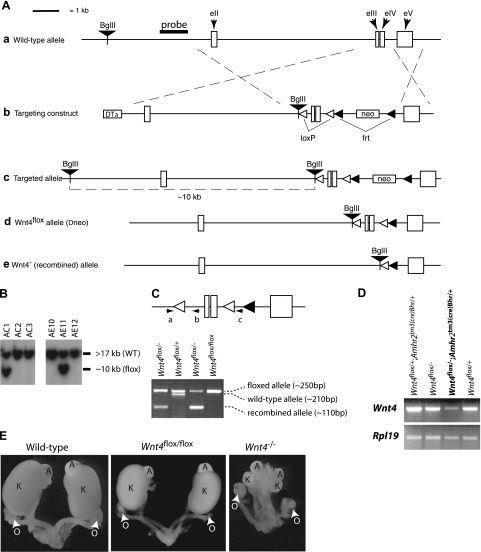Figure 1.
Conditional targeting of Wnt4 in granulosa cells. A) Illustration of the strategies used to generate the Wnt4flox and Wnt4− alleles, as detailed in Materials and Methods. LoxP sites were inserted upstream of the third (eIII) and downstream of the fourth (eIV) exons. a) Placement of the genomic DNA probe used for Southern blotting. b) Targeting construct. c) Targeted allele. d) Wnt4flox allele. e) Wnt4− (i.e., Cre-recombined) allele. DTα, diphtheria toxin α chain; neo, neomycin resistance cassette. B) Generation of embryonic stem cell lines heterozygous for the targeted Wnt4 allele. Presence of the targeted allele was detected as a 10-kb BglII restriction fragment by Southern blotting (clones AC1 and AE11). WT, wild type. C) PCR genotyping analysis strategy (top panel) and typical results from tail biopsies (bottom panel). Oligonucleotides (a–c) were designed to generate PCR products of 250 bp for the Wnt4flox allele (a), 210 bp for the Wnt4+ allele (b), and 110 bp for the Wnt4− allele (c). D) RT-PCR analysis of Wnt4 expression in ovaries from mice of different genotypes. Results demonstrate markedly decreased Wnt4 expression in Wnt4flox/−;Amhr2tm3(cre)Bhr/+ mice relative to controls. E) Urogenital tracts from newborn mice of the indicated genotypes. Wnt4−/− mice generated by recombination of the Wnt4flox allele have developmental kidney defects identical to those previously reported in Wnt4-knockout mice, indicating that recombination of the Wnt4flox allele results in complete loss of function. O, ovary; A, adrenal; K, kidney.

